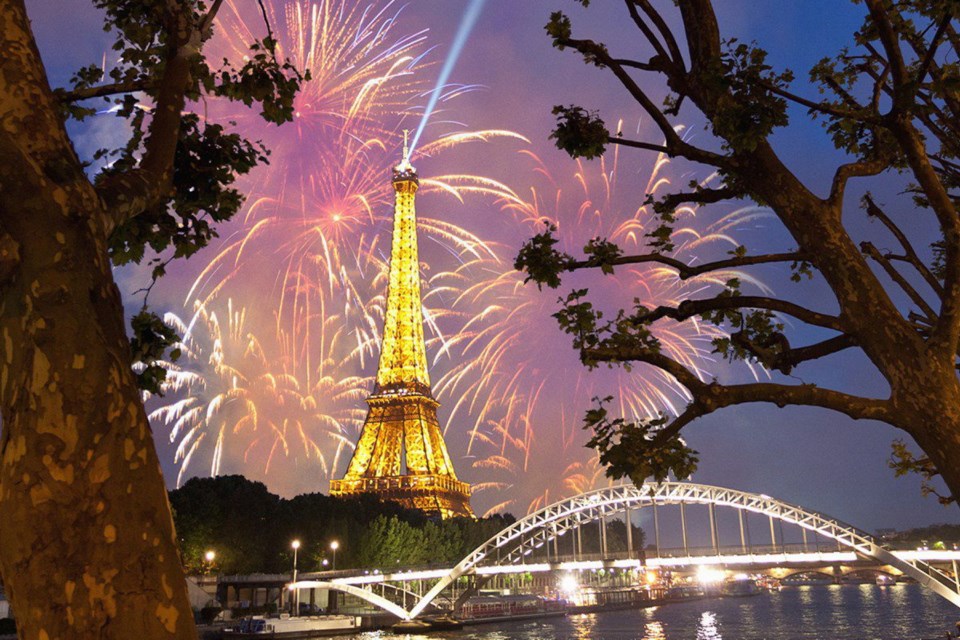For the ultimate summer party in France, visit over July 14: Bastille Day, the country’s big national day. This summer holiday is celebrated with gusto, with all-night parties, picnics and fireworks. And the fun permeates the country, from tiny towns to Paris.
The day marks the symbolic start of the French Revolution, which brought down its powerful monarchy.
In 1789, France was under the tyranny of its king, bishops and nobles. The corrupt monarchy spent lavishly, while the people suffered in poverty. The intimidating fortress of Bastille, with eight towers and 100-foot-high walls, had long functioned as a state prison — and epitomized the callous oppression of King Louis XVI. In the streets of Paris, a revolution simmered.
On the morning of July 14, an angry mob gathered around the Bastille’s main gates while the king’s troops hunkered down inside. Two citizens scaled the huge wall, cut the chains of the drawbridge and brought it crashing down. The mob poured through and was met with gunfire. Dozens were killed, and hundreds wounded. Nevertheless, revolutionaries opened dark dungeons and brought prisoners into the light of day, then paraded victoriously through Paris. The Revolution had begun.
Virtually no trace of the original Bastille fortress remains today; the revolutionaries dismantled it brick by brick. But the spirit of the Revolution lives on in the square where it all began: the Place de la Bastille. Today, the kickoff of the Revolution is celebrated every year with French pride and colour on what we now call “Bastille Day” — which the French usually just call “le 14 juillet.” In truth, festivities actually begin the night before on July 13.
Paris hosts the biggest and most iconic Bastille Day celebrations, with a huge open-air block party centred on the Place de la Bastille. Tens of thousands crowd around the statue of Winged Liberty — a chaotic scene that vaguely resembles the mobs that swarmed there two centuries ago.
While the main celebration orbits the Place de la Bastille, some of the best parties are on smaller neighbourhood squares. Most of these are Firemen’s Balls, sponsored by local fire stations to benefit charities. For a small donation, tourists and locals alike are welcome to join the fun. Bars, cafés, and outdoor stages feature big-name acts as well as local talent. Food, drink and music spill out into the street. The time I was lucky enough to celebrate alongside Parisians, the first thing I thought in the middle of all that chaos and intensity was, “Boy, I hope the fire marshal doesn’t come by.” And then it occurred to me that we were at the fire station … and that the marshal was probably right there in the crowd partying.
The next morning, on July 14, festivities take on a more sober and patriotic tone. Thousands line the Champs-Elysées — Europe’s most renowned boulevard — for a grand military parade. The parade route itself is a reminder of the Revolution: It starts at the towering Arc de Triomphe, built to honour the Revolution’s high-water mark, when France’s citizen-army triumphed over Europe’s monarchies. But the parade ends with a grim reminder of the Revolution’s darkest days at the Place de la Concorde, where a tall obelisk marks the spot where once stood the most gruesome and feared symbol of the Revolution — the guillotine.
The finale of Bastille Day unfolds on the big field of the Champ de Mars, where the first Bastille Day anniversary took place in 1790. The Revolutionaries marked the occasion with a festival they called “La Fête de la Fédération.” They gathered in this spot — where the Eiffel Tower would one day be built — and reflected on the incredible changes of the previous year. That first Bastille Day was a heady celebration of their new-found freedom. Members of every social class gathered here to mingle equally, hugging and kissing. Fireworks lit up the night, and once-starving people feasted on rich food and fine wine. In jubilation, they shouted what had long been kept inside: Liberty! Equality! Fraternity!
These days, some 500,000 revellers gather on the lawn at the Champ de Mars park and spend the day picnicking with baguettes and wine at the base of the Eiffel Tower. When darkness falls, all eyes turn up to watch the lights turn on, and to see the iconic tower glitter and glow with golden bulbs. Fireworks sparkle with the French flag’s colours — blue, red, and white.
The storming of the Bastille transformed more than just France. It inspired many other nations to demand liberty — to progress from medieval oppression to modern democracy. Anyone with a sense of history can recognize the enormous debt the world owes to those brave Parisians who stormed the Bastille to fight for a government of the people. It’s a cultural rallying point, symbolizing freedom of all kinds. If you’re in France on Bastille Day, join the proud locals in their sheer joy of personal liberty. Indeed, wherever you are on July 14, lift a glass to freedom and declare, “Vive la France!”
Rick Steves (ricksteves.com) writes European travel guidebooks and hosts travel shows on public television and public radio. Email him at [email protected] and follow his blog on Facebook.



